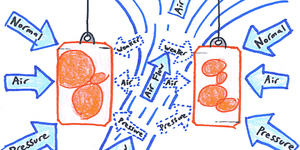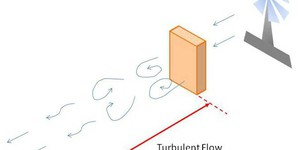Others Like “Spinning Your Wheels: Pinwheel Sensitivity” (top 20 results)
|
Did you know that you can actually make objects come together by blowing air between them? Find out how wind changes air pressure to bring to objects together in this easy and fun science fair project!
Read more
When you think of successful inventions from the 1900's that have dramatically changed how people live, what comes to mind? The car? Radio? TV? The computer? What about the microwave oven? You might not remember a time when microwave ovens were not a standard part of most kitchens, but your parents or grandparents probably do. They can remember when heating leftovers took a good 30 minutes in a traditional oven. Or thawing a food from the freezer meant leaving it in the refrigerator overnight.…
Read more
Watch out! Eddies and vortexes are powerful regions of air and water flow that you have to watch out for in some surprising places. Try out this science fair project to discover why they can be dangerous, as well as where and how to find them.
Read more
Did you know that your body has a built-in cooler? And it might not be what you think! Sweat is produced when you are hot, but its purpose is actually to cool your body as the water in it evaporates from your skin. In this science fair project, you'll use the energy produced when water evaporates to cool down chocolate-covered candy so it doesn't melt.
Read more
Do you enjoy watching cartoons and animated movies? Do you have fun playing video games? What do all of these things have in common? Fantastic computer animation, that's what! It's a cool job to take an interesting story or game and make it more entertaining by animating it. In this computer science project, you won't animate a full-length feature movie, but you will animate a pinwheel—a project that can go a long way toward creating your own longer animations! You will create an animated…
Read more
Renewable energy is the energy that is extracted from natural sources, such the Sun (solar), earth (geothermal), wind, and water (hydropower). These sources are renewable because they can be replenished by the same natural sources within a short period of time. Hydropower energy is extracted from moving water, like ocean wave energy and tidal energy. In this energy science fair project, you will make a model of a tidal barrage (also known as a dam) and investigate how emptying the tidal barrage…
Read more
Up, up, and away! If you have ever made a wish and blown the fluff of a dandelion, you have witnessed how some plants are adapted to spreading their seeds using the wind. The tiny, furry parachute allows the seeds to be picked up by the wind and to be carried far away from their parent plant. In this experiment, you will make models of seeds and fruit to investigate dispersal by wind and to evaluate
the relationship between the structure of the seed and its ability to be dispersed by the…
Read more
Have you heard the term windchill used before? Maybe on the TV weather forecast? The windchill factor describes what happens to an object (like your body) when it is cold and windy outside. As wind increases, heat is carried away from the body at a faster rate, driving down both skin temperature (which can cause frostbite) and eventually the internal body temperature (which, in extreme cases, can lead to death). In this science fair project, you will use a device to measure wind speed (an…
Read more
Making your own bubble solution is fun, but sometimes the bubbles don't seem to work as well as the solutions you buy in the store. In this experiment you can test if adding corn syrup or glycerin to your bubble solution will make it just as good as the stuff you can buy. This experiment will have you blowing bubbles!
Read more
A strobe light can illuminate an entire room in just tens of microseconds. Inexpensive strobe lights can flash up to 10 or 20 times per second. This project shows you how to use stroboscopic photography to analyze motion.
Read more
|
Explore Our Science Videos
Build A Pizza Box Solar Oven
Ion Wind Rotor V2
Make a Water Strider - STEM Activity













